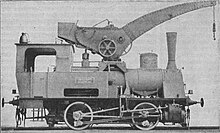Badische X
| Badische X | |
|---|---|
| Numbering: | 149 |
| Number: | 1 |
| Manufacturer: | Andrew Barclay Sons & Co. |
| Year of construction (s): | 1895 |
| Retirement: | 1898 |
| Type : | B n2t |
| Gauge : | 1435 mm ( standard gauge ) |
| Length over buffers: | 6250 mm |
| Total wheelbase: | 1524 mm |
| Empty mass: | 24.40 t |
| Service mass: | 28.50 t |
| Friction mass: | 28.50 t |
| Wheel set mass : | 14.25 t |
| Top speed: | 30 km / h |
| Coupling wheel diameter: | 914 mm |
| Control type : | Stephenson |
| Number of cylinders: | 2 |
| Cylinder diameter: | 280 mm |
| Piston stroke: | 457 mm |
| Boiler overpressure: | 9.0 bar |
| Number of heating pipes: | 86 |
| Heating pipe length: | 2400 mm |
| Grate area: | 0.60 m² |
| Radiant heating surface: | 3.72 m² |
| Tubular heating surface: | 28.80 m² |
| Evaporation heating surface: | 32.52 m² |
| Water supply: | 1.5 m³ |
| Fuel supply: | 0.3 tons of coal |
| Brake: | Westinghouse air brake |
The single vehicle of type X of the Grand Ducal Baden State Railways was a crane locomotive . The locomotive, which was delivered in 1895, was removed from the operating stock in 1898.
history
The machine was delivered in 1895 by the Scottish manufacturer Andrew Barclay Sons & Co. from Kilmarnock . The locomotive was given the number 149 and was used in the main workshop in Karlsruhe. The design common in Great Britain was withdrawn after just three years. Nothing is known about the reasons. In contrast to the English railways, the Baden railway had enough crane systems and shunting locomotives so that such a combination could not show its advantages.
Constructive features
The long boiler was made of two shots . The steam dome sat on the front and the crane on the rear shot. The sheet metal frame of the locomotive was inside. The spring was carried out by means of leaf spring packages over the axles .
The two-cylinder wet steam engine worked on the rear coupling axle. The Stephenson control was internal. The crane was operated by two separate twin steam engines.
The locomotive had a Westinghouse air brake. The sandpit was on the sheet metal. The two water boxes were next to the long boiler.
The crane rested on a trestle in the middle of the locomotive. The crane could lift around 3 to 5 tons and was installed above the boiler. The boom could only be turned, but not raised.
literature
- Hermann Lohr, Georg Thielmann: Baden Locomotive Archive (= Railway Vehicle Archive 2, 7) . transpress, Berlin 1988, ISBN 3-344-00210-4 .
